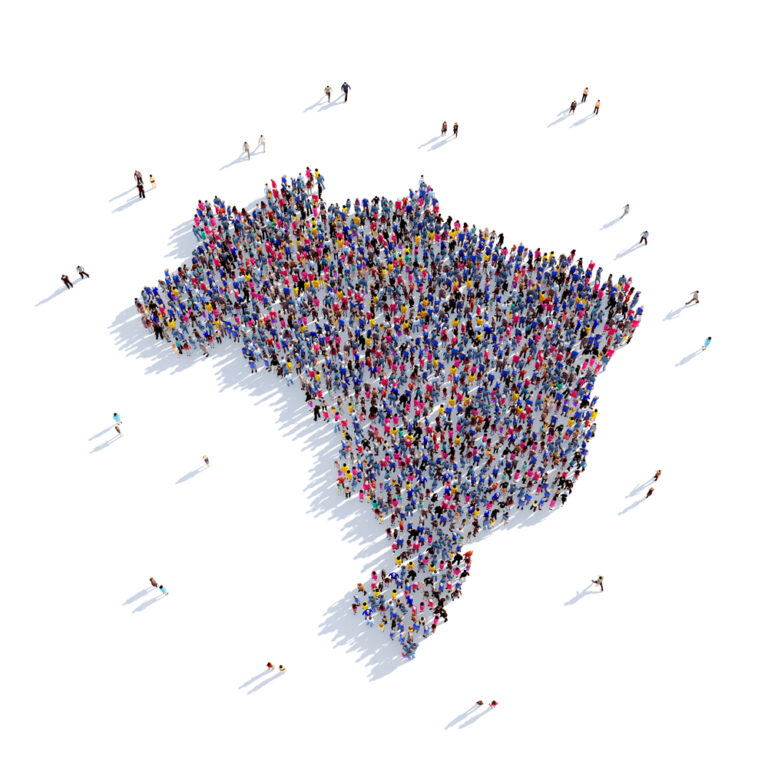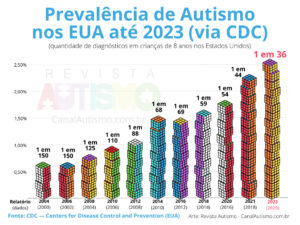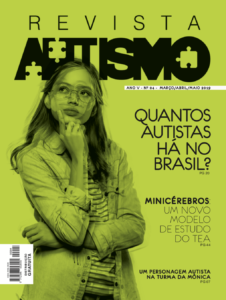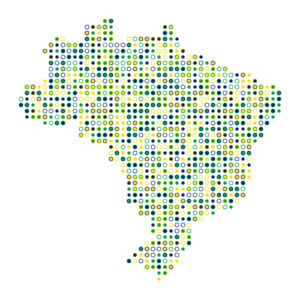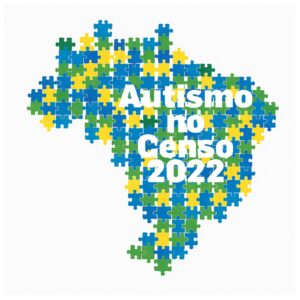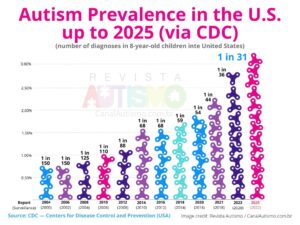Tempo de Leitura: 7 minutos
To be precise, we can have at least 5,997,222 autistic people in the country today (and counting…)
>> Portuguese version🇧🇷
In this article, I try to explain the reasons, based on scientific studies, why we can estimate that Brazil may currently have 6 million autistic people or more! There has been no research conducted in the country, and the latest Census has not published any results. It is purely statistical and logical with the scientific research carried out around the world and, mainly, with the update, on the last day of March 23, 2023, of the prevalence of autism in the United States, released by the Centers for Disease Control and Prevention (CDC) — in English: Centers for Disease Control and Prevention, an agency of the US government.
The math is quite simple: if the prevalence in the United States is 2.8% of the population of 8-years-old children (and these are not data from today, they refer to the year 2020!) — and among adults, this can only increase with late diagnoses and considering that autism is a lifelong health condition — in Brazil, the number may be similar, since there is no evidence that the prevalence is different in any other country, according to neuroscientist Alysson Muotri, professor in the Departments of Pediatrics and Cellular & Molecular Medicine at the University of California (USA). Having more than 213.3 million Brazilian inhabitants, according to the projection of the Brazilian Institute of Geography and Statistics (IBGE) for 2021, 1 in every 36 inhabitants equals 5.295 million. Considering the prediction for today — 215.9 million —the projected number of autistic people could reach 5.997 million! And that number, logically, only increases because even while maintaining the same prevalence, more people are born daily, right? And, with our inference, out of every 36 births, at least 1 could be an autistic baby.
It is a consensus that the progressive increase in this prevalence, according to leading experts in the field, is the result of more information, more awareness, and better training of health and education professionals in the United States — there are no more autistic people, there are more diagnoses ( and with much broader criteria compared to the past). And for the first time, the percentage of autism diagnoses among Asians (3.3%), Hispanics (3.2%), and blacks (2.9%) was higher than among white 8-year-olds (2. .4%). This number is the opposite of the racial and ethnic differences seen in previous CDC studies. These changes may reflect better screening and more access to services among historically underserved groups in the US. Imagine Brazil!
Late diagnoses
And in reality, the prevalence may be even higher, as the US study is limited to 8-year-olds. The number is already higher when the study expands the age range, as published last year, in July 2022, as it considers “late” diagnoses after aged 8 years. A recently published study in Jama Pediatrics conducted research with a sample size of 12,554 individuals. It utilized data from 2019 and 2020, as well as information and records from the CDC. The findings revealed that in the United States, the prevalence of autism among children and adolescents between the ages of 3 and 17 is estimated to be 1 in 30.
The main difference between this 1 in 36 study is their scope: one is limited to 8-year-olds; the other is from 3 to 17-year-old people. Therefore, they are different surveys and should not be compared as equals.
But here is my question: what if we consider people over 17? What about late diagnoses in adult life, so frequent today? Every week I receive the news of an autistic father or mother who has just had their own diagnosis (and reported by themselves to me!), this considering only within my network of contacts! Could that number be even greater than 1 in 30? If so, we would easily pass the 7 million Brazilians. I look forward to an update on this more comprehensive CDC study.
Another essential point is to clarify that I am talking about autistic people. I’m not just talking about people diagnosed or with an autism report. The spectrum of autism is vast and covers the most varied forms of this health condition, this neurodivergence. Do we have 6 million diagnostic reports? Of course not! Do we have effective public policies for these, at least 6 million people? Unfortunately, neither. It’s a battle that will last for a long time to come!
No numbers
No official numbers are available for the number of people with autism in Brazil. However, a small pilot study was conducted in 2011 in a neighborhood in the city of Atibaia (SP), which had only 20,000 residents. The scientific paper was led by Dr. Marcos Tomanik Mercadante, a well-known child and adolescent psychiatrist specializing in autism, but unfortunately passed away the same year. This pilot study found approximately 1 in 367 children in that particular neighborhood with autism.
In 2019, I wrote a report titled “How many autistic people are there in Brazil?” which was featured on the cover of Revista Autismo #4. In this report, I interviewed psychologist Sabrina Bandini Ribeiro, who holds a Ph.D. in psychiatry and medical psychology and was one of the authors of the first study on autism prevalence in Brazil. She emphasized that “this research is essential in helping policymakers understand the needs of people with autism and where they are located, so they can make informed decisions and create policies that best serve this population.”
Sabrina also contributed to another pilot study conducted in 2018, which focused on the average age of autism diagnosis in the city with the highest gross domestic product (GDP) in Brazil, São Paulo. The findings revealed that the average age of diagnosis was 4 years and 11 and a half months (4.97 years old), but with significant variation. This suggests that more studies are needed to understand this issue better. For comparison, a more extensive study conducted in 11 states in the US also in 2018 found that the average age of diagnosis was 4 years old.
‘Mapa Autismo Brasil’
I’m going to give a “spoiler” here. There is a project (still embryonic, it’s true!) to draw a sociodemographic profile of autistic people in Brazil called “Mapa Autismo Brasil” (in English, something like “Brazil Autism Map”) — @mab.autismo on Instagram. It is an initiative led by researcher and music therapist Ana Carolina Steinkopf (she already put autism on the agenda in Fantástico, the biggest Brazil’s Sunday journalistic TV show, in 2015 with “Uma Sinfonia Diferente”, a musical starring autistic people) from Brasília (DF), which aims to unite universities to carry out research (initially non-governmental) at the national level. “Using this data, we will be able to think of efficient strategies for the community’s needs,” explained Ana Carolina.
Revista Autismo is learning about the project to support the initiative and contribute to making it happen. Who knows, maybe this is a first step towards having an autism prevalence study across the country in the future?!
Brazil census
In the 2022 Census, the Brazilian Institute of Geography and Statistics (IBGE) included a question about autism in its Sample Questionnaire, which is more detailed and used in a smaller portion of the population: 11%. We are estimated to have 78 million permanent private households in the country. The sample questionnaire—with the autism question—will therefore cover a sample of approximately 8.5 million homes.
The question is as follows: “Have you ever been diagnosed with autism by a health professional?” with a yes or no answer. Census data collection was scheduled to end in October last year but is still ongoing and should be completed in the coming weeks. The final result of the Census is expected by 2025.
The question is only in the current Census due to Law 13,861 of 2019, enacted in July 2019, with the help of presenter Marcos Mion, who went to Brasília for this. “After four hours of meeting and much discussion on all sides, the autistic community was heard, respected, and contemplated,” said Mion.
Autistic Adults in the US
A recent study by the CDC in the United States found that 2% of the population on the autism spectrum is over 18 years old, which amounts to nearly 5.5 million people. The data used in the study was from 2017. The prevalence of adults with ASD varied across states, from 1.97% in Louisiana to 2.42% in Massachusetts. California, Texas, New York, and Florida had the highest estimated number of autistic adults, with 701,669, 449,631, 342,280, and 329,131 individuals, respectively. Unfortunately, in Brazil, there is no available data on the number of adults with autism.
Studies around the world
If you’re interested in learning more about the prevalence of autism around the world, a website called Spectrum News has created an online map (prevalence.spectrumnews.org) that provides information from various scientific studies. The website is frequently updated, and you can download the data. The map includes a pilot study from Brazil, so be sure to look if you want to know more about autism prevalence in your country and other parts of the world.
Below, I put couple links to various sources (Portuguese sources are linked to automatic Google translation) I used for those wanting to investigate the subject.
EXTRA CONTENT
- CDC Complete Prevalence Study: Prevalence and Characteristics of Autism Spectrum Disorder Among 8-Years-Old Children, 2020
- CDC 4-Year-Old Study: Early Identification of Autism Spectrum Disorder Among Children Aged 4 Years, 2020
- More comprehensive 2022 study with the prevalence of autism in people aged 3 to 17 years
- CDC Autism Page: CDC – Autism Spectrum Disorder (ASD)
- CDC Data Page: Autism Data Visualization Tool | CDC
- Previous CDC study (2018, released 2021): Prevalence of ASD: 1 in 44
- Adult autism study released in 2022 (with 2017 data): ncbi.nlm.nih.gov/pmc/articles/PMC9128411/
- Spectrum News Online Map: All Published Autism Prevalence Scientific Studies.
- Bill 6575/2016 — Includes specificities inherent to autism in the demographic census as of 2018. Amends Law No. 13,146, of 2015: https://www.camara.leg.br/proposicoesWeb/fichadetramitacao?idProposicao=2118686
- Interview by Sabrina Bandini Ribeiro for Revista da Fapesp: http://revistapesquisa.fapesp.br/2018/01/16/mais-uma-possivel-causa-do-autismo/
Epidemiological study of Portugal in 2000: https:// istogeral.sib.uc.pt/handle/10316/848 - IBGE included a question about autism in the 2022 Census questionnaire – Revista Autismo / Canal Autismo
- Autism prevalence: 1 in 36 is the new number of the CDC in the US – Revista Autismo / Canal Autismo
- How many autistics are there in Brazil? – Autismo Magazine / Autismo Channel
- What is Autism? – Autismo Magazine / Autismo Channel
 Francisco Paiva Jr.
Francisco Paiva Jr.